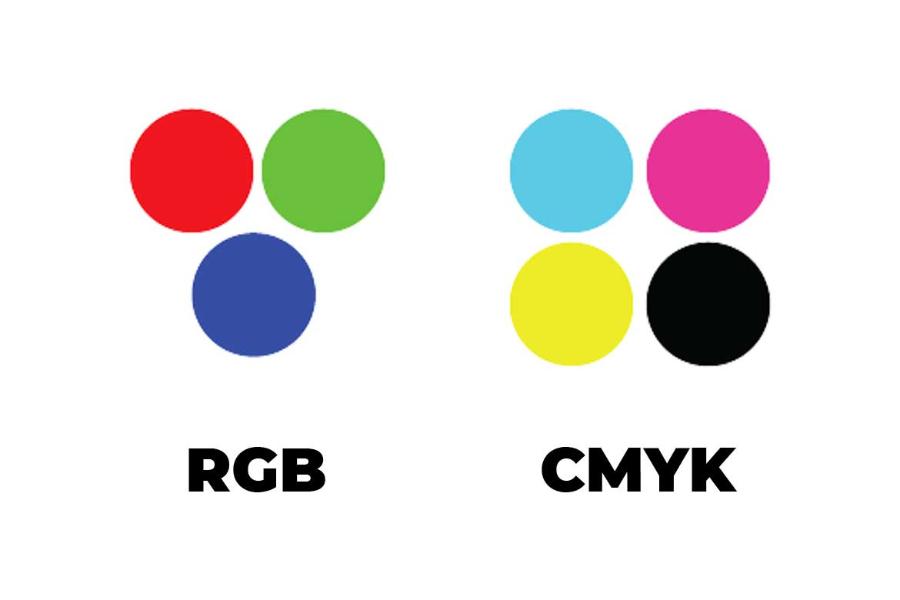Best Selling Products
Comprehensive Understanding of CMYK and RGB Color Systems: Differences & Applications
Nội dung
- 1. Introduction to the Two Color Systems CMYK and RGB
- 2. CMYK Color System: Printing and Color on Paper
- 2.1 How the CMYK color system works
- 2.2 Applications of CMYK
- 3. RGB Color System: Colors On Digital Screens
- 3.1 How the RGB color system works
- 3.2 Applications of RGB
- 4. The Difference Between CMYK and RGB Color Systems
- 4.1 Operating principle
- 4.2 Application
- 4.3 Color Differences
- 5. Why Choose CMYK Or RGB Depending On The Purpose Of Use
- 6. Conclusion
Learn about the two color systems CMYK and RGB, the differences between them, and their applications in graphic design, printing, and digital imaging. This detailed article will help you understand these two important color systems.

The CMYK and RGB color systems are two basic but extremely important concepts in graphic design and printing. Understanding the characteristics, applications and differences between them will help you optimize your design work and ensure the quality of the final product. Let's explore each color system in detail with Sadesign through the article below.
1. Introduction to the Two Color Systems CMYK and RGB
In the world of digital graphics and imaging, understanding color systems is an important factor in creating quality products. CMYK and RGB color systems are two popular color systems used in design, printing, and digital applications. However, each color system has its own principles and operating methods, serving different purposes.
.jpg)
CMYK and RGB are two popular color systems used in the fields of design, printing and display technology. The CMYK color system, which stands for Cyan, Magenta, Yellow and Key (Black), is commonly used in the printing industry because it matches the way inks are mixed to create different colors. Meanwhile, the RGB color system, which stands for Red, Green and Blue, is mainly used in display devices such as computer monitors, televisions and mobile phones, where light is combined to reproduce colors. Understanding the characteristics and applications of each color system is very important to ensure the quality and accuracy of design products in practice.
2. CMYK Color System: Printing and Color on Paper
CMYK stands for four primary colors: Cyan , Magenta , Yellow, and Key . This is the color system used primarily in printing, especially in creating images and prints on paper. The structure of the CMYK color system is based on the subtractive color method , meaning that colors are created by gradually reducing the light reflected from the printing inks.
2.1 How the CMYK color system works
In CMYK, each primary color is mixed together to create other colors. The printing process uses inks of these four colors, in varying proportions, to create images. These colored inks are printed onto paper, gradually reducing the light reflected from the surface, creating the colors that the human eye perceives.
For example, when printing an image with red, Magenta and Yellow inks will be used to create a red blend. If a dark or black image is needed, Key (Black) ink will be used to increase the darkness. When printing, the light that hits the printing surface will be absorbed by the ink layers, and the color that the human eye sees is the light that is reflected. This process allows for accurate reproduction of the color gamut from a digital image to a printed piece. CMYK is commonly used in the printing industry, especially offset printing, due to its ability to reproduce colors faithfully and optimize production costs.
2.2 Applications of CMYK
.jpg)
This is a subtractive color model, which works on the principle of absorbing light to create different colors. CMYK plays an important role in ensuring the quality and accuracy of colors when transferring from digital screens to actual prints. The CMYK color system is mainly used in the printing industry. Applications include:
Printing documents, brochures, flyers : This is one of the most common applications of the CMYK color system. The mixing of colors from CMYK inks helps to create prints with sharp quality and accurate colors. This helps to ensure that the printed product has the closest color to the original design, especially important in areas such as printing books, magazines, product packaging and advertising materials.
Printing pictures, product packaging : Packaging products or art pictures when printed on paper or other materials also often use the CMYK color system.
Printing on special materials : This color system is also applied when printing on fabric, plastic or special materials that require precise color mixing.
In Color Management: CMYK also plays an important role in color management, especially when working on projects that require color consistency across different printers or materials. Software tools such as Adobe Photoshop, Illustrator or InDesign all support CMYK mode, allowing users to test and adjust colors before going into production.
In Graphic Design: In graphic design, the use of CMYK is an important preparation step when creating products for print. Designers often convert from RGB (used for digital screens) to CMYK to ensure that colors appear correctly on print. For example, logo design, business cards, posters, and marketing materials all need to adhere to the CMYK standard to achieve optimal results.
3. RGB Color System: Colors On Digital Screens
RGB is a color system used in electronic display devices such as computers, phones, televisions and projectors. RGB stands for three primary colors: Red , Green and Blue . The RGB color system works on the principle of additive color , in which these three primary colors are combined to create different colors.
3.1 How the RGB color system works
Unlike CMYK, RGB uses light to create color. Each pixel on the screen has three small colored dots (red, green, and blue). When the light from these dots combines, they create the colors that the human eye perceives.
Red : Created by emitting red light.
Green : Created by emitting green light.
Blue : Created by emitting blue light.
When these three colors are combined in different proportions, they can create millions of different colors. This explains why computer screens and digital devices can display so many colors.
3.2 Applications of RGB
.jpg)
The RGB color system is used primarily in devices with light-emitting displays, and its most common application is in fields related to digital graphics. Some applications of RGB include:
Graphic Design : Designers use the RGB color system when working with graphic design software like Photoshop, Illustrator or other photo editing software.
Digital advertising and online media : Advertising banners, websites, and mobile applications all use RGB to display sharp and vivid images.
Videos and movies : Videos, movies, and television shows all use the RGB color system to display images on a television or computer screen.
4. The Difference Between CMYK and RGB Color Systems
While both CMYK and RGB are popular color systems in design and communications, they have distinct differences in how they work and are used. Here are the key differences between the two:
.jpg)
4.1 Operating principle
CMYK is based on the use of four primary colors: Cyan, Magenta, Yellow and Key to create different colors through the process of mixing colors using the subtractive method. When printing, these colors are layered on the surface of the paper, each layer absorbing some of the light and reflecting the rest, creating the desired color. This is a popular color system in the printing industry, especially offset printing, thanks to its ability to reproduce colors accurately and cost-effectively compared to other color systems such as RGB. Controlling the proportions and intensities of each color in the CMYK system plays an important role in ensuring the quality and fidelity of printed images.
RGB uses three primary colors: Red, Green, and Blue. This is an additive color system, in which colors are created by mixing light of these three primary colors at different intensities. When all three colors are combined at their maximum intensity, they form white, while no light is emitted, it forms black. Varying the ratio of red, green, and blue components creates a rich color spectrum, which is widely used in display devices such as computer monitors, televisions, and lighting systems. This principle plays an important role in modern digital imaging and display technology.
4.2 Application
CMYK is the primary choice for printing, including printing documents, images, and product packaging.
RGB is used in digital graphic design, websites, mobile applications and electronic display devices such as televisions, computers and phones.
4.3 Color Differences
CMYK can produce accurate and faithful colors when printed on paper, but can have difficulty reproducing bright and vibrant colors.
RGB is capable of producing a wider range of colors, especially bright and vibrant colors, since direct light is used to create the colors.
5. Why Choose CMYK Or RGB Depending On The Purpose Of Use
Choosing between CMYK and RGB depends on your intended use and the type of media you are working with. If you are working with print, you will definitely want to use CMYK to ensure accurate colors. On the other hand, if you are working with digital devices or need to create images for websites or applications, you will need to use RGB to achieve vivid and accurate colors.
6. Conclusion
CMYK and RGB are two important color systems in the world of design and communication, each serving different purposes. Understanding the differences between them and applying them appropriately will help you create products with accurate, sharp colors, thereby improving the quality of your work and communication effectiveness. Whether it is print or digital graphic design, choosing the right color system will determine the success of the project you are working on.












































